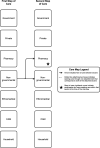Qualitative study of pathways to care among adults with diabetes in rural Guatemala
- PMID: 36609334
- PMCID: PMC9827254
- DOI: 10.1136/bmjopen-2021-056913
Qualitative study of pathways to care among adults with diabetes in rural Guatemala
Abstract
Objective: The burden of diabetes mellitus is increasing in low-income and middle-income countries (LMICs). Few studies have explored pathways to care among individuals with diabetes in LMICs. This study evaluates care trajectories among adults with diabetes in rural Guatemala.
Design: A qualitative investigation was conducted as part of a population-based study assessing incidence and risk factors for chronic kidney disease in two rural sites in Guatemala. A random sample of 807 individuals had haemoglobin A1c (HbA1c) screening for diabetes in both sites. Based on results from the first 6 months of the population study, semistructured interviews were performed with 29 adults found to have an HbA1c≥6.5% and who reported a previous diagnosis of diabetes. Interviews explored pathways to and experiences of diabetes care. Detailed interview notes were coded using NVivo and used to construct diagrams depicting each participant's pathway to care and use of distinct healthcare sectors.
Results: Participants experienced fragmented care across multiple health sectors (97%), including government, private and non-governmental sectors. The majority of participants sought care with multiple providers for diabetes (90%), at times simultaneously and at times sequentially, and did not have longitudinal continuity of care with a single provider. Many participants experienced financial burden from out-of-pocket costs associated with diabetes care (66%) despite availability of free government sector care. Participants perceived government diabetes care as low-quality due to resource limitations and poor communication with providers, leading some to seek care in other health sectors.
Conclusions: This study highlights the fragmented, discontinuous nature of diabetes care in Guatemala across public, private and non-governmental health sectors. Strategies to improve diabetes care access in Guatemala and other LMICs should be multisectorial and occur through strengthened government primary care and innovative private and non-governmental organisation care models.
Keywords: anthropology; general diabetes; international health services; primary care; public health; qualitative research.
© Author(s) (or their employer(s)) 2023. Re-use permitted under CC BY-NC. No commercial re-use. See rights and permissions. Published by BMJ.
Conflict of interest statement
Competing interests: PR is the principal investigator to receive the National Institutes of Health/Fogarty International Center grant (1R21TW010831-01) that funded this study. ANC receives support from the Houston Veterans Administration Health Services Research and Development Center for Innovations in Quality, Effectiveness and Safety (CIN13-413).
Figures




Similar articles
-
Hybrid Hospital-at-Home Program in Singapore: Ethnographic Study.J Med Internet Res. 2025 Jun 2;27:e66107. doi: 10.2196/66107. J Med Internet Res. 2025. PMID: 40456139 Free PMC article.
-
Towards a patient-centred definition for atopic dermatitis flare: a qualitative study of adults with atopic dermatitis.Br J Dermatol. 2024 Jun 20;191(1):82-91. doi: 10.1093/bjd/ljae037. Br J Dermatol. 2024. PMID: 38287887
-
Recommendations for Designing a Digital Health Tool for Blindness Prevention Among High-Risk Diabetic Retinopathy Patients: Qualitative Focus Group Study of Adults With Diabetes.JMIR Form Res. 2025 Jun 13;9:e65893. doi: 10.2196/65893. JMIR Form Res. 2025. PMID: 40513002 Free PMC article.
-
Assessing the comparative effects of interventions in COPD: a tutorial on network meta-analysis for clinicians.Respir Res. 2024 Dec 21;25(1):438. doi: 10.1186/s12931-024-03056-x. Respir Res. 2024. PMID: 39709425 Free PMC article. Review.
-
Pharmacological and electronic cigarette interventions for smoking cessation in adults: component network meta-analyses.Cochrane Database Syst Rev. 2023 Sep 12;9(9):CD015226. doi: 10.1002/14651858.CD015226.pub2. Cochrane Database Syst Rev. 2023. PMID: 37696529 Free PMC article.
Cited by
-
Many hops, many stops: care-seeking "loops" for diabetes and hypertension in three urban informal settlements in the Mumbai Metropolitan Region.Front Public Health. 2024 Jan 9;11:1257226. doi: 10.3389/fpubh.2023.1257226. eCollection 2023. Front Public Health. 2024. PMID: 38264249 Free PMC article.
-
Impact of COVID-19 on diabetes care: mixed methods study in an Indigenous area of Guatemala.BMJ Open. 2024 Jan 2;14(1):e079130. doi: 10.1136/bmjopen-2023-079130. BMJ Open. 2024. PMID: 38167279 Free PMC article.
-
Rethinking HIV care for youth: Insights from qualitative research with youth in Chad.PLoS One. 2025 Jun 24;20(6):e0309497. doi: 10.1371/journal.pone.0309497. eCollection 2025. PLoS One. 2025. PMID: 40554476 Free PMC article.
References
Publication types
MeSH terms
Substances
Grants and funding
LinkOut - more resources
Full Text Sources
Medical
